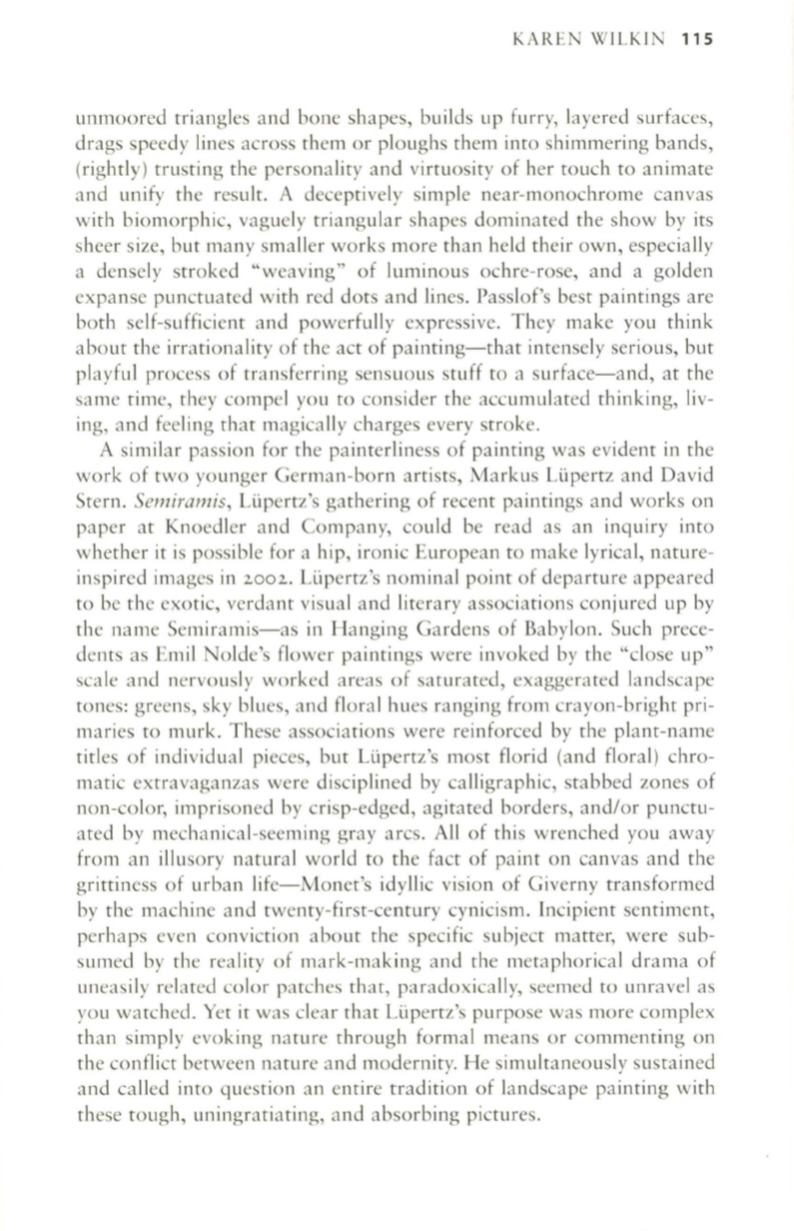
KAREN WILKIN
115
unmoored triangles and bone shapes, builds up furry, layered surfaces,
drags speedy lines across them or ploughs them into shimmering bands,
(rightly ) trusting the personality and virtuosity of her touch to animate
and unify the result. A deceptively simple near-monochrome canvas
with biomorphic, vaguely triangular shapes dominated the show by its
sheer size, but many smaller works more than held their own, especially
a densely stroked "weaving" of luminous ochre-rose, and a golden
expanse punctuated with red dots and lines. Passlof's best paintings are
both self-sufficient and powerfully expressive. They make you think
about the irrationality of the act of painting-that intensely serious, but
playful process of transferring sensuous stuff to a surface-and, at the
same time, they compel you to consider the accumulated thinking, liv–
ing, and feeling that magically charges every stroke.
A similar passion for the painterliness of painting was evident in the
work of two younger German-born artists, Markus LLipertz and David
Stern.
Semiramis,
LLipertz's gathering of recent paintings and works on
paper at Knoedler and Company, could be read as an inquiry into
whether it is possible for a hip, ironic European to make lyrical, nature–
inspired images in
2002.
LLipertz's nominal point of departure appeared
to be the exotic, verdant visual and literary associations conjured up by
the name Semiramis-as in Hanging Gardens of Babylon. Such prece–
dents as Emil Nolde's flower paintings were invoked by the "close up"
scale and nervously worked areas of saturated, exaggerated landscape
tones: greens, sky blues, and floral hues ranging from crayon-bright pri–
maries to murk. These associations were reinforced by the plant-name
titles of individual pieces, but Li.ipertz's most florid (and floral) chro–
matic extravaganzas were disciplined by calligraphic, stabbed zones of
non-color, imprisoned by crisp-edged, agitated borders, and/or punctu–
ated by mechanical-seeming gray arcs. All of this wrenched you away
from an illusory natural world to the fact of paint on canvas and the
grittiness of urban life-Monet's idyllic vision of Giverny transformed
by the machine and twenty-first-century cynicism. Incipient sentiment,
perhaps even conviction about the specific subject matter, were sub–
sumed by the reality of mark-making and the metaphorical drama of
uneasily related color patches that, paradoxically, seemed to unravel as
you watched. Yet it was clear that Li.ipertz's purpose was more complex
than simply evoking nature through formal means or commenting on
the conflict between nature and modernity. He simultaneously sustained
and called into question an entire tradition of landscape painting with
these tough, un ingratiating, and absorbing pictures.


